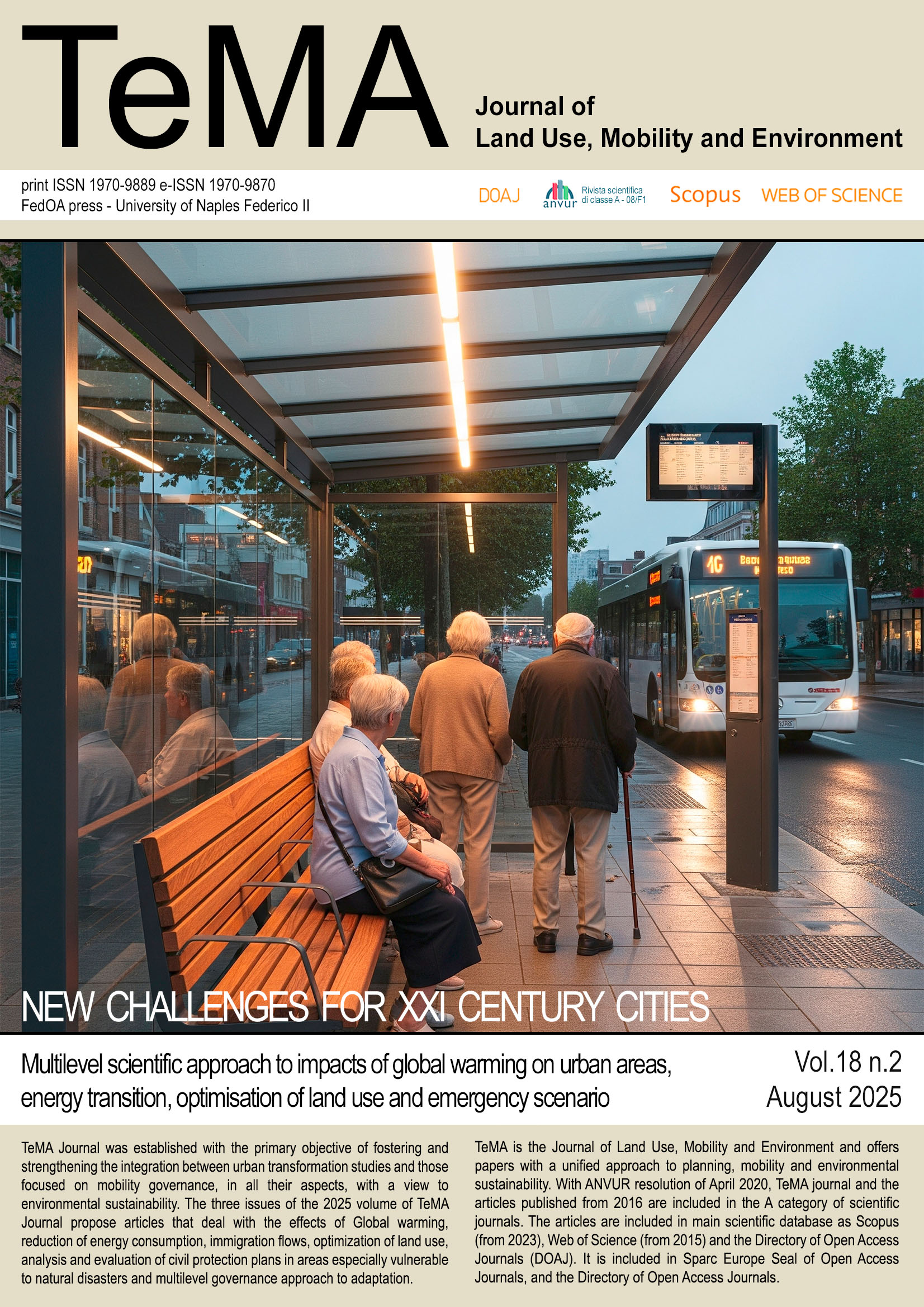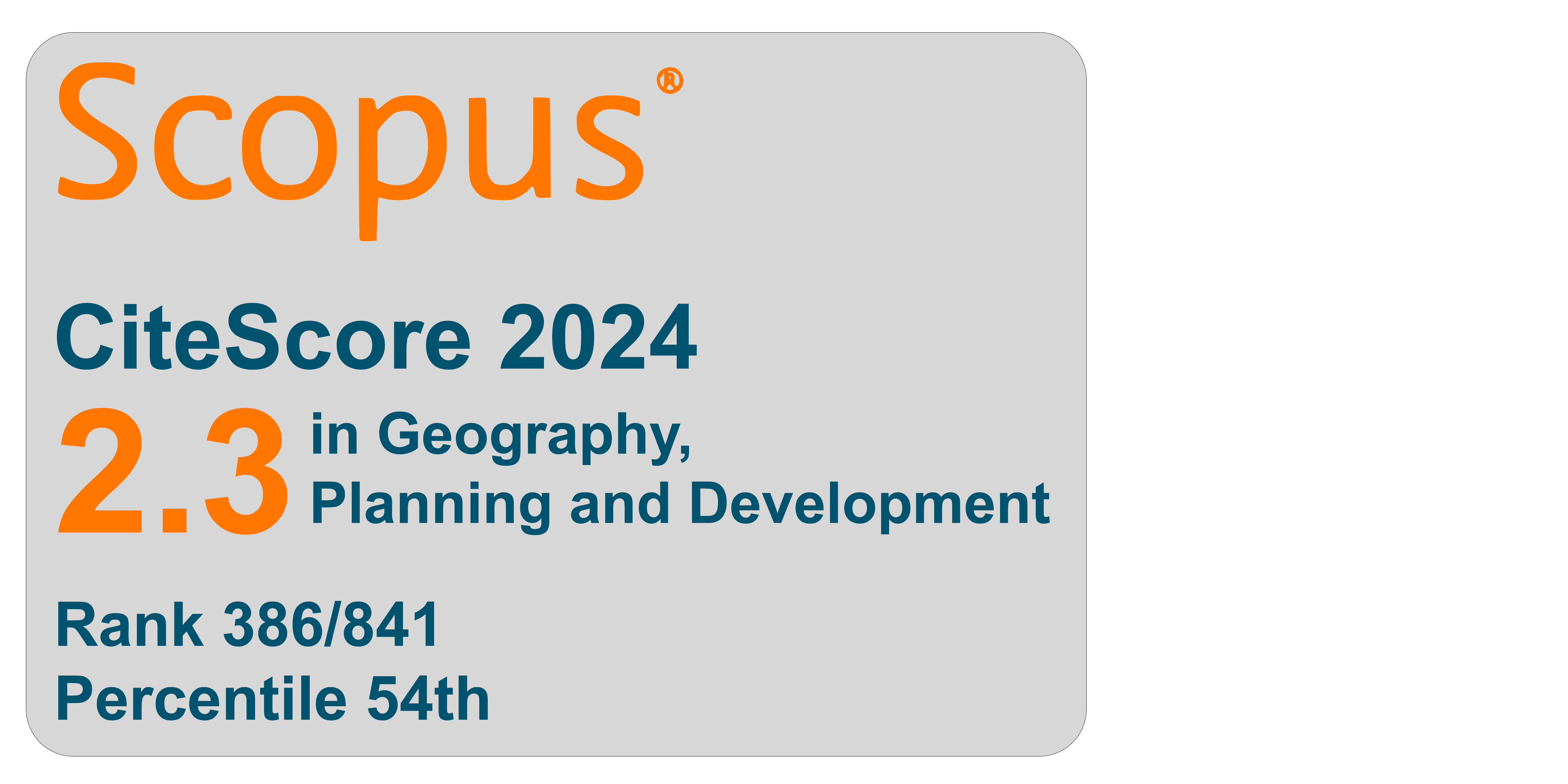Exploring open and green space characteristics for climate change adaptation: a focus on flooding phoenomenon
DOI:
https://doi.org/10.6093/1970-9870/12350Keywords:
Open space, Green areas, Literature review, Climate change adaptation, Flooding risksAbstract
Starting from the relationship between urban planning and mobility management, TeMA has gradually expanded the view of the covered topics, always remaining in the groove of rigorous scientific in-depth analysis. This section of the Journal, Review Notes, is the expression of continuously updating emerging topics concerning relationships between urban planning, mobility, and environment, through a collection of short scientific papers written by young researchers. The Review Notes are made of five parts. Each section examines a specific aspect of the broader information storage within the main interests of TeMA Journal. In particular, the Urban planning literature review section presents recent books and journals on selected topics and issues within the global scientific panorama.
For the second issue of TeMA Journal volume no. 18, this section provides a comprehensive overview of the challenges and solutions related to the role of open and green spaces in climate change adaptation, with particular attention to the urban flooding risks. Using a variety of scientific sources and practical resources, this contribution aims to identify the key characteristics of these spaces that can influence adaptation strategies, examining the solutions proposed in the scientific literature, specifically in books, journals, and reports.
Downloads
References
Andersson, E., Barthel, S., Borgström, S., Colding, J., Elmqvist, T., Folke, C., & Gren, Å. (2014). Reconnecting Cities to the Biosphere: Stewardship of Green Infrastructure and Urban Ecosystem Services. AMBIO, 43 (4), 445-453. https://doi.org/10.1007/s13280-014-0506-y
Barbarossa, L., Pappalardo, V., & La Greca, P. (2021). Water-related risk reduction in urban development plans: Recommendations for resilient planning practices from a Sicilian case study investigation. TeMA - Journal of Land Use, Mobility and Environment, 7–23. https://doi.org/10.6093/1970-9870/7680
Duan, H. F., Li, F., & Tao, T. (2016). Multi-objective Optimal Design of Detention Tanks in the Urban Stormwater Drainage System: Uncertainty and Sensitivity Analysis. Water Resources Management, 30 (7), 2213-2226. https://doi.org/10.1007/s11269-016-1282-1
European Commission (2019). The European Green Deal. Retrieved from: https://commission.europa.eu/strategy-and-policy/priorities-2019-2024/european-green-deal_en
Fletcher, T. D., Shuster, W., Hunt, W. F., Ashley, R., Butler, D., Arthur, S., ... & Mikkelsen, P. S. (2015). SUDS, LID, BMPs, WSUD and more–the evolution and application of terminology surrounding urban stormwater management. Urban Water Journal, 12 (7), 525-542. https://doi.org/10.1080/1573062X.2014.916314
Gómez-Baggethun, E., & Barton, D. N. (2013). Classifying and valuing ecosystem services for urban planning. Ecological Economics, 86, 235-245. https://doi.org/10.1016/j.ecolecon.2012.08.019
Guerreiro, S. B., Dawson, R. J., Kilsby, C., Lewis, E., & Ford, A. (2018). Future heat-waves, droughts and floods in 571 European cities. Environmental Research Letters, 13 (3), 034009. https://doi.org/10.1088/1748-9326/aaaad3
Kabisch, N., Frantzeskaki, N., Pauleit, S., Naumann, S. (2016). Nature-based solutions to climate change mitigation and adaptation in urban areas: Perspectives on indicators, knowledge gaps, barriers, and opportunities for action. Ecology and Society, 21 (2). https://doi.org/10.5751/es-08373-210239
Klijn, F., Asselman, N., & Van der Most, H. (2018). Compartmentalisation and risk reduction along the Rhine: does it work? Hydrological Sciences Journal, 63 (11), 1525-1535. https://doi.org/10.1111/j.1753-318x.2009.01047.x
Lai, S., Isola, F., Leone, F., & Zoppi, C. (2021). Assessing the potential of green infrastructure to mitigate hydro-geological hazard: Evidence-based policy suggestions from a Sardinian study area. TeMA - Journal of Land Use, Mobility and Environment, 109–133. https://doi.org/10.6093/1970-9870/7411
Lepczyk, C. A., Aronson, M. F., Evans, K. L., Goddard, M. A., Lerman, S. B., & MacIvor, J. S. (2017). Biodiversity in the city: fundamental questions for understanding the ecology of urban green spaces for biodiversity conservation. Bioscience, 67 (9), 799-807. https://doi.org/10.1093/biosci/bix079
Liquete, C., Udias, A., Conte, G., Grizzetti, B., & Masi, F. (2016). Integrated valuation of a nature-based solution for water pollution control. Highlighting hidden benefits. Ecosystem Services, 22, 392-401. https://doi.org/10.1016/j.ecoser.2016.09.011
Magni, F., Litt, G., & Carraretto, G. (2021). Metropolitan Cities supporting local adaptation processes. The case of the Metropolitan City of Venice. TeMA - Journal of Land Use, Mobility and Environment, 14 (2), 125–144. https://doi.org/10.6093/1970-9870/7948
Mguni, P., Herslund, L., & Jensen, M. B. (2016). Sustainable urban drainage systems: examining the potential for green infrastructure-based stormwater management for Sub-Saharan cities. Natural Hazards, 82 (2), 241-257. https://doi.org/10.1007/s11069-016-2309-x
Mohamed Thariq, M. G., & Mohamed Mujithaba Mohamed, N. (2024). Environmental factors affecting living comfort perception in different localities in Sri Lanka. TeMA - Journal of Land Use, Mobility and Environment, 17 (3), 473–486. https://doi.org/10.6093/1970-9870/10865
Mora-Esteban, R., Conejo- Arrabal, F., Romero-Martínez, J. M., & Nebot-Gómez de Salazar, N. (2025). Problems and restoration strategies of urban mediterranean rivers in Spain. Guadalmedina river as a potential ecological corridor in the green-blue infrastructure of Malaga, Spain. TeMA - Journal of Land Use, Mobility and Environment, 55–77. https://doi.org/10.6093/1970-9870/11115
Morel, J. L., Chenu, C., & Lorenz, K. (2014). Ecosystem services provided by soils of urban, industrial, traffic, mining, and military areas (SUITMAs). Journal of Soils and Sediments, 15 (8), 1659-1666. https://doi.org/10.1007/s11368-014-0926-0
Pauleit, S., Zölch, T., Hansen, R., Randrup, T. B., & Konijnendijk van den Bosch, C. (2017). Nature-based solutions and climate change–four shades of green. In Nature-based solutions to climate change adaptation in urban areas, 29-49. Springer. https://doi.org/10.1007/978-3-319-56091-5_3
Pennino, S. (2024). Global warming or global warning? A review of urban practices for adaptation to urban floods. TeMA - Journal of Land Use, Mobility and Environment, 17 (3), 517–524. https://doi.org/10.6093/1970-9870/11167
Salvadore, E., Bronders, J., & Batelaan, O. (2015). Hydrological modelling of urbanized catchments: a review and future directions. Journal of Hydrology, 529, 62-81. https://doi.org/10.1016/j.jhydrol.2015.06.028
Santoro, S., Mastrodonato, G., & Camarda, D. (2024). Managing local knowledge about NBS in spatial planning. A group model building approach. TeMA - Journal of Land Use, Mobility and Environment, 17 (2), 265–283. https://doi.org/10.6093/1970-9870/10810
Shi, Y., Sasaki, K., Ando, R., Leung, L. R., & Im, E. S. (2020). Effects of climate change on heating and cooling degree days and potential energy demand in the household sector of Japan. Energy Policy, 140, 111433. https://doi.org/10.3354/cr01360
Staccione, A., Essenfelder, A. H., Bagli, S. & Mysiak, J. (2024). Connected urban green spaces for pluvial flood risk reduction in the Metropolitan area of Milan. Sustainable Cities and Society, 105288–105288, https://doi.org/10.1016/j.scs.2024.105288
UN-Habitat (2016). New Urban Agenda. Habitat III. Quito: United Nations Human Settlements Programme. Retrieved from: https://unhabitat.org/the-new-urban-agenda-illustrated#:~:text=The%20New%20Urban%20Agenda%2C%20adopted%20at%20Habitat%20III,construction%2C%20development%2C%20management%20and%20improvement%20of%20urban%20areas
UN-Habitat (2020). World Cities Report 2020: The Value of Sustainable Urbanization. Nairobi: United Nations Human Settlements Programme. Retrieved from: https://unhabitat.org/wcr/2020/
UNDRR (2015). Sendai Framework for Disaster Risk Reduction 2015-2030. Geneva: United Nations Office for Disaster Risk Reduction. Retrieved from: https://www.undrr.org/publication/sendai-framework-disaster-risk-reduction-2015-2030
UNFCCC (2015). Accordo di Parigi. Framework Convention on Climate Change. Paris: United Nations. Retrieved from: https://unfccc.int/process-and-meetings/the-paris-agreement
UN (2015). Trasformare il nostro mondo: l'Agenda 2030 per lo Sviluppo Sostenibile. New York: United Nations General Assembly. Retrieved from: https://sdgs.un.org/2030agenda
Downloads
Published
How to Cite
Issue
Section
License
Copyright (c) 2025 Tonia Stiuso

This work is licensed under a Creative Commons Attribution-NonCommercial 4.0 International License.



